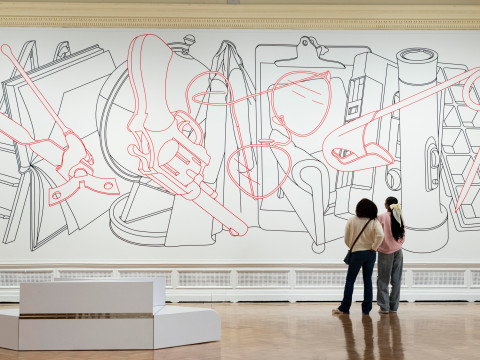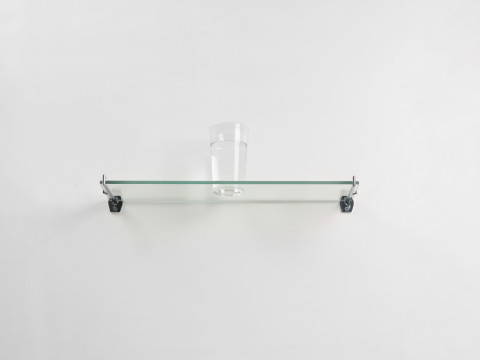
Start here: Michael Craig-Martin
Published on 8 August 2024
Find out more about the artistic career of Michael Craig-Martin before you visit our latest exhibition.

Seeing things differently
Michael Craig-Martin wants you to see familiar things differently.
Over the last 60 years, he has used sculpture, installation, painting, drawing and print to challenge the ways we view ordinary objects. He began his career by creating conceptual sculptures and installations, but since the 1990s he has used bold colour and simple uninflected lines to represent everyday objects.
Craig-Martin’s influence extends beyond his own work; as an art educator, he has inspired generations of artists, including the YBAs.

Changing a glass of water into an oak tree
When he left art school in the 1960s, leaving America for London, Craig-Martin made conceptual sculptures.
Works such as On the Shelf and On the Table use milk bottles or buckets to create precariously balanced sculptures. In the former, milk bottles are tilted at an alarming angle, whereas the water line inside suggests a safe balance. In the latter, buckets filled with water simultaneously stand on and support the table beneath due to a pulley system.
In his most famous early work, An Oak Tree, Craig-Martin presents a glass of water on a shelf accompanied by a text in which he declares that he has transformed the object into a tree. In a later interview, the artist argues that “the fact it doesn’t look like an oak tree is neither here nor there because I didn’t change its appearance, but I’ve changed it into an oak tree”.

Finding objects
After the minimalism of An Oak Tree Craig-Martin began looking for new directions to take his work. He continued to experiment with readymade objects, producing a series of works made using closed Venetian blinds and he made simplified drawings of everyday objects using neon lights.
In the late 1970s, Craig-Martin made a series of wall drawings of instantly recognisable manufactured objects – books, globes, lightbulbs, stepladders. He used tape to remove any of the flaws that come from drawing by hand. When you buy manufactured objects new “they’re perfect” Craig-Martin says, “and I wanted my drawings to have the same quality of precision”.

Now in colour
Craig-Martin's exhibition at the British School at Rome in 1993, flooded the gallery with colour. He painted half the room in cream and dark green and the other half in pink, adding drawings of objects over bright backgrounds. He took a similar approach to an exhibition in Paris later that year.
This was a turning point for Craig-Martin who said in a 2019 interview with Elephant Magazine “I painted the walls in colour, and my life changed forever.”
After his colour breakthrough in the early 90s, he turned to painting, making large-scale works such as Common History and Eye of the Storm, which combine commonplace objects into a colourful composition. As with his earlier wall drawings, Craig-Martin continued to use tape to create “perfect” lines.
The arrangement of objects in these compositions is often ambiguous, inviting the viewer to reach for their own narratives and, in doing so, look at familiar things with fresh eyes.

Using text
Keen to address more abstract concepts, in the early 2000s Craig-Martin made a series of works that incorporated text. He developed a visual alphabet in which each letter corresponded to an object, with no apparent connection – A is an umbrella, B is a wine glass and so on.
The letters are treated in the same way as the objects in the Word Paintings, outlined and overlayed. Terms such as ‘death’, ‘sex’ or ‘art’ are presented alongside an assortment of objects, inviting the viewer to consider the relationship between abstract concepts and the tangible things in our lives.

Paying homage to art history
More recently, Craig-Martin has made a series of works that pay homage to his favourite artists by re-imagining iconic works of art in his signature style.
Like Pablo Picasso and Richard Hamilton before him, Craig-Martin has re-imagined Diego Velázquez’s Las Meninas. He has also re-interpreted other masterpieces of art history, such as Manet’s A Bar at the Folies-Bergère and Seurat’s Bathers at Asnières.
By treating these artworks in the same way he treats objects and breaking the compositions down with clear lines, Craig-Martin draws attention to details in the original works.

Responding to new times and technologies
This exhibition features new work by Craig-Martin. His recent series of fruit paintings were made in response to the Covid-19-induced lockdowns, when the only outing one was allowed was a trip to the supermarket. Another pandemic-inspired work, Zoom 2, acknowledges the ways that social interaction in lockdown was only possible through screens.
Laptop computers and other technology such as iPhones, headphones and credit cards have become a regular feature of Craig-Martin's work – replacing filing cabinets, cassettes and cash registers. He’s also fascinated by the potential of technological advances to create new work. Created especially for this exhibition, Cosmos is the artist’s first 360-degree digital installation. It engulfs the viewer in the world of his objects and like the exhibition itself, looks back at Craig-Martin's career.
In his own words, “It’s a summation of the cosmos, of my cosmos, of what I’ve done”.
Michael Craig-Martin is in our Main Galleries from 21 September to 10 December 2024

Book tickets for Michael Craig-Martin
Discover Michael Craig-Martin's 60-year career at the largest and most comprehensive exhibition of his work ever held in the UK.
Related articles

Start here: Brazilian Modernism
22 January 2025

Video: drawing on gallery walls with tape
15 October 2024

Video: changing a glass of water into an oak tree
15 October 2024